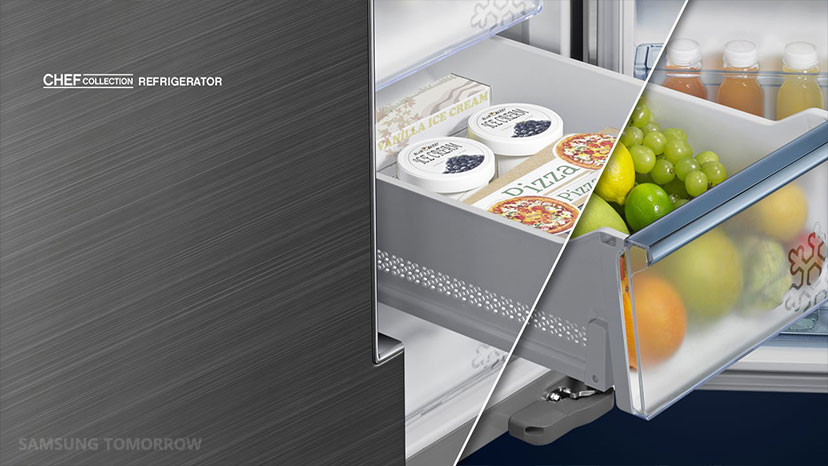How to Keep Your Fridge Cleaner and Your Food Fresher
on July 23, 2015
The old adage is true: it’s all about location, location, location. Especially when it comes to cold storage. And where you store your food, along with the way in which you organize and clean your refrigerator, determine the freshness and shelf life of your produce, pasteurized products and leftover pizza. Follow this fridge maintenance plan to keep all of it fresh and flavorful.
Temperature
Though many are not aware that certain foods must be maintained at certain temperatures and humidity levels, these two factors play a vital role in optimizing the freshness of food. For starters, bacteria starts tripling at 40 degrees Fahrenheit (4 degrees Celsius), and freezes at 32 degrees Fahrenheit (zero degrees Celsius) so keep the temperature at an optimal 37 degrees Fahrenheit to slow the growth of bacteria. Be sure to occasionally check the internal temperature to ensure your appliance is working properly.
Ensuring that this temperature is steady is also of great importance. Improved technological advancements in refrigeration, such as Samsung’s innovative Triple Metal Cooling steel panels, ensure a steady temperature and have greatly improved food freshness. For specific cooking and serving needs, like chilling drinks before a party or marinating meat, utilize temperature-controlled compartments.
Furthermore, you should minimize the number of times you open the fridge door, check to ensure that the door is sealed and let cooked foods cool down before putting them away to ensure constant and consistent cooling.
It should also be noted that certain food items require specific temperatures. Dairy products, for example, spoil easily and as such should be placed in the coolest part of the refrigerator — near the bottom, in the back — while products with more preservatives, like condiments and orange juice, are okay on the door, where temperatures tend to fluctuate. Avoid cramming too much into your fridge and place items in a way so that air can properly circulate between them to create a uniform temperature with fewer warm spots. Take note of foods that don’t need to be refrigerated, such as potatoes, tomatoes, onions and honey, to conserve space.
Humidity
Humidity levels can also impact the freshness of food. The general rule of thumb is that foods that wilt (like arugula, spinach and herbs) should be placed in a high humidity environment, while foods that rot (i.e. fruits and vegetables that emit ethylene gas, such as apples and pears) should be placed in a low humidity setting.
Newer cold storage appliances are designed in a way to allow for optimized freshness through humidity controlling features. Take the Samsung Chef Collection refrigerator, for example. While the appliance’s Triple Cooling technology, which uses three evaporators and two compressors to control temperature and humidity, promotes an air quality that ensures great freshness, its Chef Basket and Chef Pantry maintain precise temperatures and humidity levels for specific foods.
Storage and Organization
This particular refrigerator was designed by the Samsung Club des Chefs, a group of culinary masters who provided valuable insight into the design and features of Samsung’s latest line of kitchen appliances. Advisor to the club and food critic Pierre-Yves Chupin notes that checking the condition of the food before putting it in the refrigerator is just as important as how it is stored.
For example, you should systematically remove the cardboard or plastic wrapping from your groceries. Fruit and vegetables should be washed before being putting away, as food that has been in direct contact with the soil should never be placed around other edible items. After washing them, you should keep salads in containers, with a layer of paper towel at the bottom and on top, to keep them fresh and crisp. Raw meats and seafood should be placed on the bottom shelf to prevent spills. If marinating or preparing the meat to cook, features such as the dishwasher-safe Chef Pan are great for temporary storage.
Leftovers can be stored for up to four days in clear glass containers and drawers and baskets should be labeled with contents regularly. Seeing what foods are left over helps you to eat them sooner, creating less food waste. Additionally, before every grocery trip, move older foods hiding in the back to the front to take inventory.
Cleaning
It is important to clean the inside of the refrigerator regularly by emptying it and washing the doors and shelves with a disinfectant such as diluted bleach. Do not spray substances directly on the surface; instead apply a small amount of cleaner on a rag and then wipe the surface. For stubborn stains, make a paste of baking soda and warm water, and apply it gently to the area with a warm soft cloth. For fingerprints and smudges, a few drops of olive oil applied with a paper towel can do wonders.
To take the hassle out of cleaning, wipe spills and messes when fresh and remove expired items to save space for fresh leftovers and foods you’ll want to eat. To keep unwanted smells at bay, try placing a saucer of coffee grinds or half a lemon inside the fridge.



